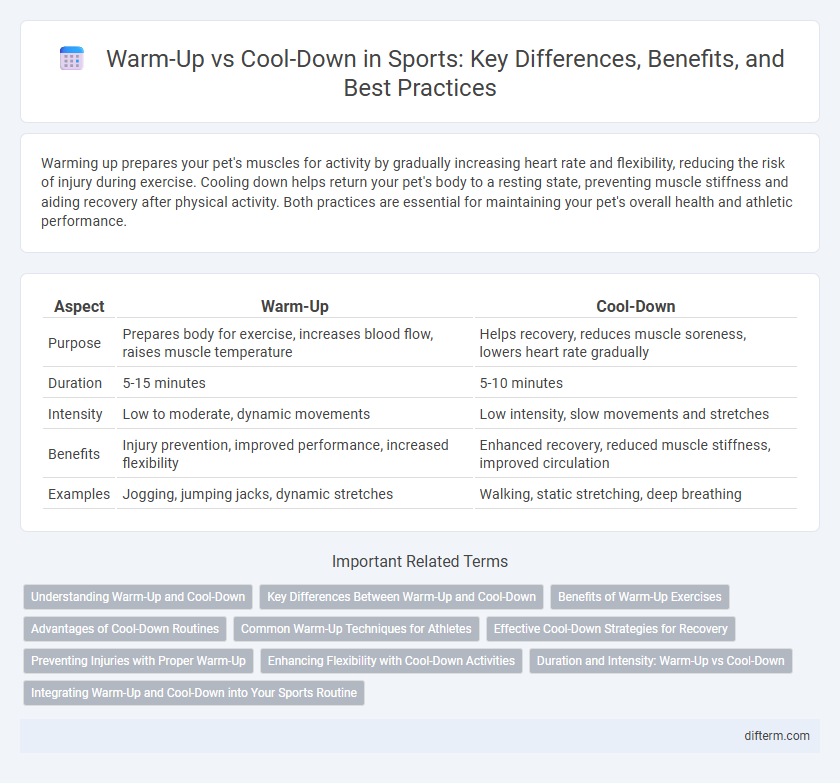Warming up prepares your pet's muscles for activity by gradually increasing heart rate and flexibility, reducing the risk of injury during exercise. Cooling down helps return your pet's body to a resting state, preventing muscle stiffness and aiding recovery after physical activity. Both practices are essential for maintaining your pet's overall health and athletic performance.
Table of Comparison
| Aspect | Warm-Up | Cool-Down |
|---|---|---|
| Purpose | Prepares body for exercise, increases blood flow, raises muscle temperature | Helps recovery, reduces muscle soreness, lowers heart rate gradually |
| Duration | 5-15 minutes | 5-10 minutes |
| Intensity | Low to moderate, dynamic movements | Low intensity, slow movements and stretches |
| Benefits | Injury prevention, improved performance, increased flexibility | Enhanced recovery, reduced muscle stiffness, improved circulation |
| Examples | Jogging, jumping jacks, dynamic stretches | Walking, static stretching, deep breathing |
Understanding Warm-Up and Cool-Down
Warm-up prepares the body by gradually increasing heart rate and loosening muscles, enhancing performance and reducing injury risk. Cool-down aids recovery by slowly lowering heart rate and stretching muscles to prevent stiffness and promote flexibility. Both are essential components of effective sports training for optimal physical and mental readiness.
Key Differences Between Warm-Up and Cool-Down
Warm-ups increase heart rate, blood flow, and muscle temperature to prepare the body for intense physical activity, reducing injury risk. Cool-downs gradually lower heart rate and help remove metabolic waste like lactic acid, aiding muscle recovery and flexibility. Warm-ups often include dynamic stretches, whereas cool-downs emphasize static stretching for muscle relaxation.
Benefits of Warm-Up Exercises
Warm-up exercises increase blood flow to muscles, enhancing oxygen delivery and reducing injury risk by improving flexibility and joint mobility. These activities activate the nervous system, boosting muscle responsiveness and coordination essential for optimal athletic performance. Improved mental focus during warm-up prepares athletes for the demands of their sport, leading to better overall results.
Advantages of Cool-Down Routines
Cool-down routines help gradually lower heart rate and prevent blood pooling, reducing the risk of dizziness or fainting after intense exercise. They enhance muscle recovery by promoting the removal of lactic acid and metabolic waste, which minimizes muscle soreness and stiffness. Incorporating static stretching during cool-down improves flexibility and reduces the risk of injury in subsequent training sessions.
Common Warm-Up Techniques for Athletes
Dynamic stretching, such as leg swings and arm circles, is a common warm-up technique that increases blood flow and prepares muscles for intense activity. Light jogging or cycling raises heart rate gradually, enhancing oxygen delivery to working muscles and reducing injury risk. Sport-specific drills mimic game movements, improving neuromuscular activation and mental readiness before competition.
Effective Cool-Down Strategies for Recovery
Effective cool-down strategies for recovery include low-intensity aerobic exercises such as walking or cycling to gradually reduce heart rate and prevent blood pooling. Incorporating static stretching post-exercise enhances flexibility and helps alleviate muscle stiffness by promoting circulation and nutrient delivery to fatigued muscles. Hydrating and performing targeted foam rolling further facilitate muscle repair and reduce delayed onset muscle soreness (DOMS), optimizing overall recovery.
Preventing Injuries with Proper Warm-Up
Proper warm-up routines increase blood flow, elevate muscle temperature, and enhance joint flexibility, significantly reducing the risk of strains and sprains during physical activity. Dynamic stretching and sport-specific exercises prepare muscles and nervous system for intense movements, optimizing performance and minimizing injury occurrence. Implementing a thorough warm-up protocol is essential for athletes seeking to prevent common sports injuries and maintain long-term physical health.
Enhancing Flexibility with Cool-Down Activities
Cool-down activities play a crucial role in enhancing flexibility by gradually lowering heart rate and promoting muscle relaxation after intense exercise. Static stretching during cool-down helps lengthen muscle fibers and improve joint range of motion, reducing stiffness and soreness. Consistent incorporation of cool-down routines supports faster recovery and long-term flexibility gains in athletes.
Duration and Intensity: Warm-Up vs Cool-Down
Warm-up sessions typically last 10 to 15 minutes with moderate intensity activities designed to gradually increase heart rate and blood flow to muscles, preparing the body for intense exercise. Cool-down periods are shorter, around 5 to 10 minutes, featuring low-intensity movements to help reduce heart rate and prevent blood pooling. Effective warm-ups optimize performance by progressively activating muscles, while cool-downs facilitate recovery and decrease the risk of post-exercise stiffness and soreness.
Integrating Warm-Up and Cool-Down into Your Sports Routine
Integrating warm-up and cool-down into your sports routine enhances performance and reduces injury risk by preparing muscles and gradually restoring heart rate, respectively. Dynamic stretches and light cardio during warm-up improve blood flow and flexibility, while static stretches and controlled breathing in cool-down aid muscle recovery and decrease stiffness. Consistent incorporation of both phases optimizes athletic longevity and overall physical resilience.
warm-up vs cool-down Infographic

 difterm.com
difterm.com